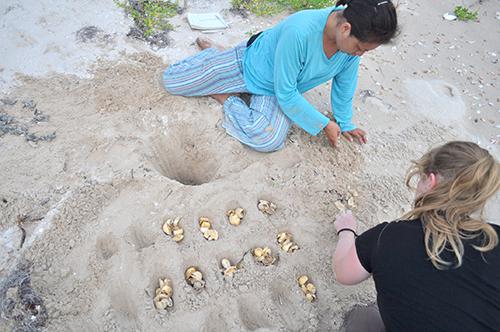Annelisse Bárcenas Ibarra
The main aim of this research is to contribute to the baseline of sea turtles congenital malformations (CMs) and to evaluate and compare prevalence levels and types of CMs in the Kemp’s ridley with other sea turtle species, as well as nest management. Population level reliable measures of CMs, are critical to identify demographic, geographic, and temporal patterns, to detect sudden increases in their occurrence, and to evaluate the efficacy of prevention and conservation efforts.

Annelisse and a volunteer cleaning a hawksbill sea turtle nest. They also identify and quantify unhatched eggs’ congenital malformations. ©Eréndira Bárc
Sea turtle conservation strategies focus on improving reproductive success, which is determined by the number of hatchlings recruited into the marine environment. This parameter is important because it is an indicator of the suitability of the beach (or hatchery) as an incubation system, and the general health of the nesting colony. Any significant change to this parameter over a time period suggests that problems may be occurring. Successful completion of embryonic development depends on high physical fitness and an optimal development environment. Genetic or environmental alterations during early development can drastically affect embryonic processes or generate congenital malformations (CMs).
CMs are common in human pathology, and domesticated and laboratory animals, but in wildlife they are mostly unknown and neglected. Emerging awareness of CMs in wild populations has attracted public and scientific concern because of the probable underlying environmental health risks to wildlife and humans. Rising trends in CM levels in wild animals is highlighted by the decrease in amphibian populations likely associated with increasing limb malformations, caused mostly by trematode infections and pollution in the wild.
CMs in wildlife may signal emerging pathological threats, but whether the phenomena are broadly applicable across taxa, or have population-scale impacts, is unknown. The first records of CMs in sea turtles, 33 years ago, stated that CMs in embryos and hatchlings were low and rare, ranging from 0.2 to less than 1%. Since 2010, I started collecting data from CMs in different sea turtle species along Mexican coasts and elsewhere. To date, I have recorded CMs prevalence in olive ridley, hawskbill, green, leatherback, and loggerhead turtles with three different nest management strategies: Styrofoam boxes, hatchery, and in situ nests; CM values range from 0.2 to 2%, and are significantly higher in artificially incubated nests. I also observed that nest with CMs showed higher mortality levels than those without CMs.
While studies focusing on the conservation and protection of sea turtles have risen in recent years, only a few address CMs; some of them describe malformation types and frequencies. Nevertheless, none of these provide a complete assessment of CMs or possible aetiologies.